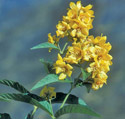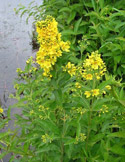Garden Loosestrife
|
|
||
Lysimachia vulgaris • Class B |
||
| Family Name: | Primulaceae (Prim-yew-lay-see-ee) | |
| Common: | Primrose family | |
| Genus: |
Lysimachia (ly-si-MAK-ee-uh) Meaning: Named for King Lysimachus, who used the plant to calm his oxen |
|
| Species: |
vulgaris (vul-GAIR-iss) Meaning: Common |
|
| Description: |
Garden Loosestrife has showy, bright yellow flowers which grow in clusters near the top of the plant. Flowers have 5 petals that are joined at the base and sometimes have a red or orange eye. The base of the flowers is ringed by green sepals that have orange-brown edges. The plants’ leaves are softly hairy, 3 to 5 inches long and egg-shaped, usually growing 3 leaves in a whorl. Garden loosestrife roots form creeping stems that are partly or entirely underground. These rhizomes can be up to 15 feet long. |
||||
| Why Is it a Noxious Plant? |
It damages shoreline and wetland ecosystems by replacing beneficial native plants. It reduces habitat needed by waterfowl, wildlife, birds and fish, including several species of salmon. |
||||
| Where Does it Grow? |
The ability of Garden Loosestrife to invade and establish itself in wetlands, lakeshores and riverbanks, threatens native species in those sensitive areas. It can out-compete most native plants, and even other invasive species like Purple Loosestrife. |
||||
| Facts: |
Identification of Garden Loosestrife is often complicated because of its name and appearance. It is related to a common ornamental species (Lysimachia punctata) also called Garden Loosestrife or Yellow Loosestrife. This plant looks very similar to Lysimachia vulgaris; however its blooms are situated in the leaf axils all the way up the main stem, not in clusters at the tops of the stalk. |
||||
| Control Options: |
|
||||
| More Information: |
Download our Flyer or visit Washington State Noxious Weed Control Board Here. Photo by Leo Michels
|
||||
| More Pictures: |
|






 Pierce County Noxious Weed Control Board • 9200 122nd St E, Puyallup, WA 98373 • 253-798-7263
Pierce County Noxious Weed Control Board • 9200 122nd St E, Puyallup, WA 98373 • 253-798-7263